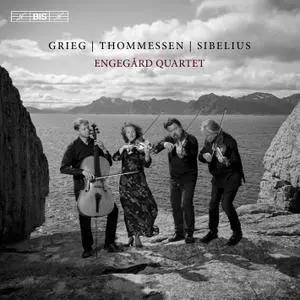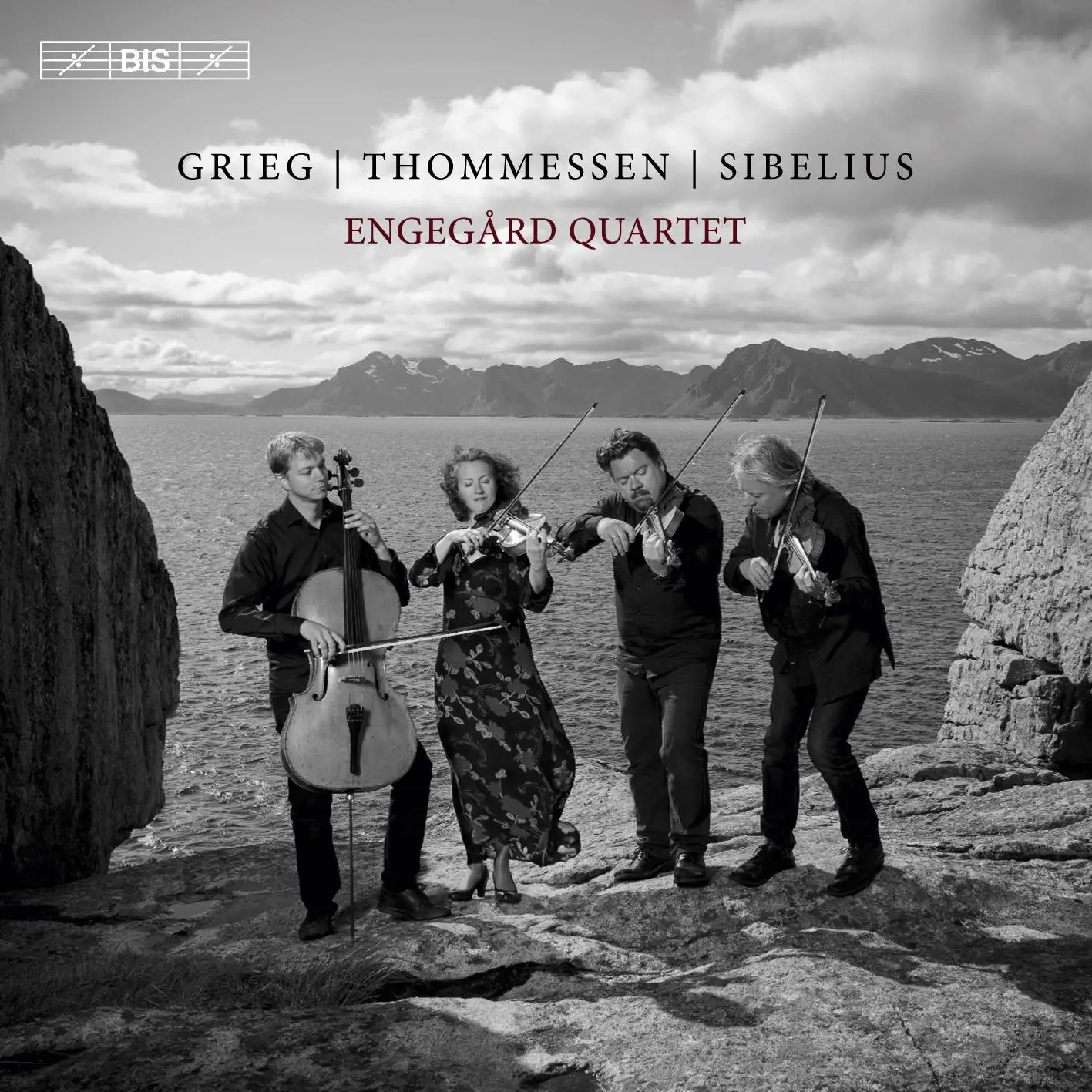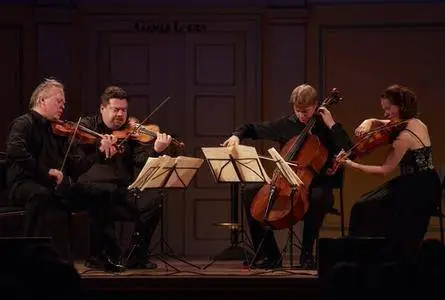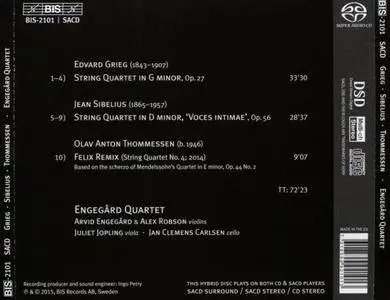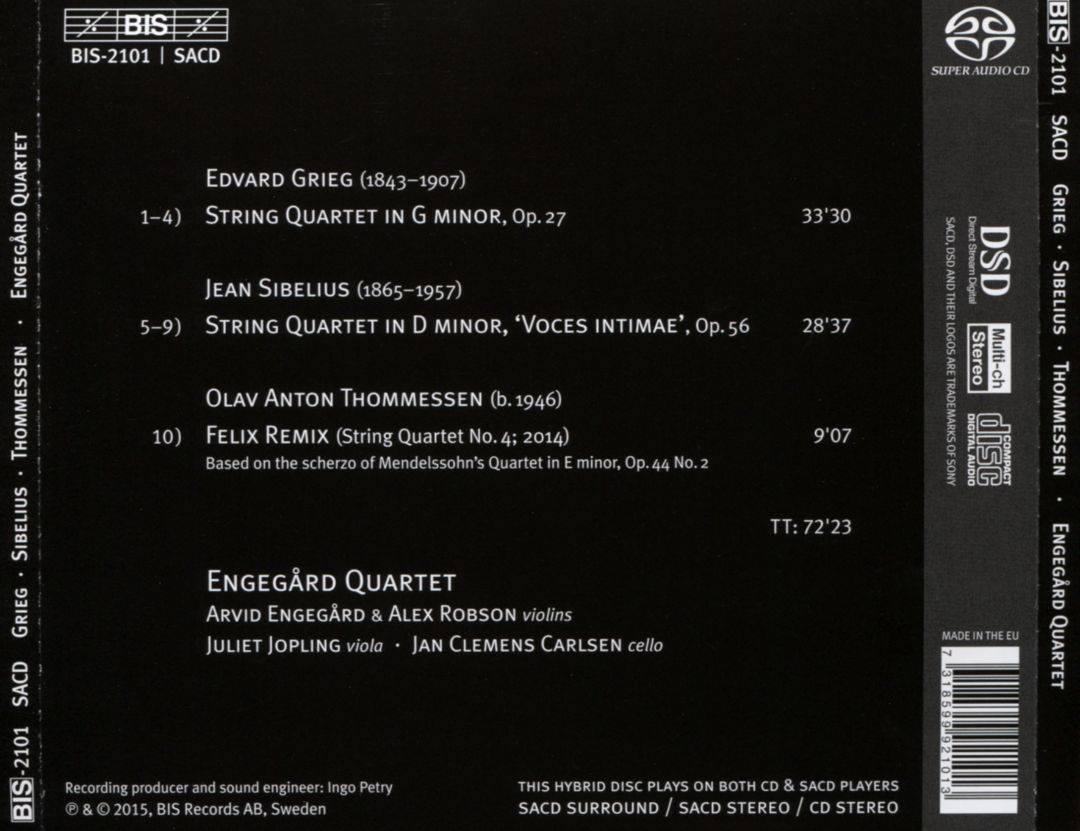Engegård Quartet - Edvard Grieg, Jean Sibelius, Olav Anton Thommessen (2015)
EAC | FLAC | Image (Cue&Log) ~ 327 Mb | Mp3 (CBR320) ~ 172 Mb | Scans included
Genre: Classical | Label: BIS | # BIS-SACD-2101 | Time: 01:12:23
EAC | FLAC | Image (Cue&Log) ~ 327 Mb | Mp3 (CBR320) ~ 172 Mb | Scans included
Genre: Classical | Label: BIS | # BIS-SACD-2101 | Time: 01:12:23
A string quartet was among the very first works that Edvard Grieg presented after completing his studies in 1861, but the Quartet in G minor, Op. 27, was the only such work to be published in his lifetime. In 1878, while composing it, Grieg wrote that ‘it aims at breadth, to soar, and, above all, at vigorous sound’, and the amplitude of the sound is indeed striking: the generous use of double-stops creates an almost orchestral effect, unusual for the genre. This caused some reviewers to criticize the quartet as being unidiomatic, while others, including Liszt, greeted it with enthusiasm. Some thirty years later, when Jean Sibelius composed his D minor quartet Op. 56, he too had previous experience of writing for the medium, but Op. 56 is the only quartet among his mature works. The often used 'nickname' Voces intimae is often taken to refer to the intimate interchange between the four voices in a quartet, but is probably a more specific allusion to a brief passage in the third movement: Sibelius wrote the remark into a score some time after the work had been published. On its first release on BIS the Engegård Quartet includes Felix Remix by Olav Anton Thommessen. The work, premièred by the Engegård Quartet in 2014, is based on the second movement, Allegro di molto, of Felix Mendelssohn’s String Quartet, Op. 44 No. 2.
The quiet E minor chords that give Sibelius’s Voces intimae its nickname occur a minute and a half into the third movement of this new recording by the Engegård Quartet. As Sibelius directs, the four players drop to a whisper; but the Engegårds’ cellist Jan Clemens Carlsen leans ever so slightly on his own double-stopped chord. It’s just enough to darken the sound, to shift its emphasis. Five minutes later, in the movement’s closing bars, the chords return; this time, though, it’s the leader Arvid Engegård who brings out his line – and, in the subtlest possible way, suggests the distance that’s been travelled since that first mysterious interruption.
It’s a detail, but one that I think gets to the heart of this fine Norwegian quartet’s approach to both major works on this disc. The Engegårds’ ensemble sound is characterful and lit from within by Carlsen and viola player Juliet Jopling. Their performances – lucidly captured by the BIS engineers – live in the moment: they’re colourful, fluently paced and feel entirely spontaneous. But the more you listen to them the more you begin to sense the intelligence and refinement, as well as the freshness, of these readings. To take another example, the droll little portamentos in Grieg’s Intermezzo become great uproarious whoops in the movement’s unbuttoned central section. The way has been prepared: it makes both expressive and structural sense.
Both these works create their own emotional atmosphere, and the Engegårds bring something of themselves to each – more up-front than the Coull Quartet in the Sibelius, more fiery in the Grieg than the Vertavo Quartet. They also include the first recording of Felix Remix, a Mendelssohn-inspired scherzo written for them by Olav Anton Thommessen and played at high voltage with crystalline precision. Quartet aficionados won’t want to part with the Budapest Quartet – but those seeking the Grieg/Sibelius pairing in modern sound would be hard pressed to find better.Review by Richard Bratby, Gramophone
I was quite surprised how many times the Grieg and Sibelius String Quartets have been yoked on disc. Apart from what some perceive as a permeating ‘Nordic sound’, what is more definite is that each composer left only one mature work in this medium, despite some early attempts. I found two recordings in my collection featuring the two works: the 1989 recording by the Guarneri Quartet (426 286), and a Biddulph recording from the 1930s with the Budapest String Quartet (LAB 098 and now in a Warner Sibelius box). The only other recording of the Grieg that I have is played by the Hagen Quartet (MYR007). The Engegård Quartet are completely new to me, but I see that they’ve recorded the Grieg previously in 2007 for the 2L label.
Grieg’s String Quartet No. 1 in G minor, Op. 27 dates from 1878 when he was thirty-five, and sits between an early student work which was lost and the third quartet which was left unfinished. In common with César Franck’s Piano Quartet of the same year, it incorporates elements of cyclical design. He borrowed from his own music, in this case the ‘Spillemænd’ (fiddlers) song from his group of Ibsen settings, Op. 25. It is announced at the beginning of the quartet in unison, woven into the fabric throughout, and makes a return in the last movement. Debussy was very taken by the work, and it influenced him to compose his sole quartet in 1893, also in G minor. The work dispels any pre-conceived notions that Grieg was at heart only a miniaturist. The chromaticism, richly textured harmonies and bold modulations certainly have a progressive feel. Grieg employs a good deal of double-stopping which creates a full-bodied, rich orchestral sonority.
The Engegård’s account is intense and passionate. There’s forceful declamation in the opening chord of the first movement, which grabs your attention immediately. The many disparate elements of the movement may cause the music to meander in some performances, but not here. The players have an eye on the bigger picture, keeping a tight grip on the narrative. The Romanza which follows is generous on memorable melody, and the quartet make the contrasts between joyous lyricism and a more agitated section. The Intermezzo has rhythmic power and drive. After a slow introduction a buoyant saltarello takes centre stage. The Engegård’s delivery is alert and assured and they pack plenty of personality into their playing.
Sibelius' String Quartet in D minor Op.56 Voces Intimae was composed 1908-1909 between the Third and Fourth symphonies, and is the only major work for string quartet of his mature period. It was premiered on 25 April 1910 at the Helsinki Music Institute. Its introspective character gives a foretaste of the Fourth Symphony, and its conversational tone is hinted at in the title ‘Intimate Voices’. Indeed the quartet begins with a mournful, dialogue between violin and cello establishing the general mood of the work. It was written under a pall of debt and illness and is cast in five movements.
This is one of the finest performances I’ve heard, capturing the contrasting moods and emotions to effect, starting with the brooding solitude of the opening movement. I particularly like the delicate, fleeting lightness of the second movement. The Adagio is the emotional heart of the work, and the Engegårds instill heartfelt passion and yearning into their reading. The finale is restless, frenetic and dispatched with energy and gusto.
Olav Anton Thommessen has, for the past thirty or so years, based his compositions on fragments of existing repertoire – in this case, Mendelssohn’s String Quartet Op. 44 No. 2. It bears the title Felix Remix and is his fourth string quartet. In it he utilizes contemporary compositional techniques, and the work abounds in glissandi and harmonics. Mendelssonian gestures interject at various points. The Engegård’s technically virtuoisic rendering evoke the galloping of horses and steam locomotives, aural images the composer intended. It provides a fascinating nine minute diversion.
This new recording is an improvement sound-wise on the Guarneri Quartet, which sounds a tad congested at times, and I also found these newcomers more considered in their approach. The Hagens, in the Grieg only, are wonderful and will act as a pleasing alternative. The Budapest Quartet likewise offer compelling accounts of the Grieg and Sibelius, albeit in 1930s sound.
The BIS engineers have done the Engegårds proud in achieving superb balance between each instrumentalist. The acoustic of the Bryn Church, Bærum, Norway couldn’t be bettered, conferring a warm, intimate ambience with just the right amount of resonance. Tomas Block’s liner contributions in English, French and German are well-written and informative. Altogether a charming disc.Review by Stephen Greenbank, MusicWeb-International.com
Engegård Quartet:
Arvid Engegård, Alex Robson (violins)
Juliet Jopling (viola)
Jan Clemens Carlsen (cello)
rec. Bryn Church, Bærum, Norway, April 2015
Tracklist:
Edvard GRIEG (1843-1907)
String Quartet in G minor, Op.27 (1877-78)
01. I. Un poco andante (11:53)
02. II. Romanze (06:38)
03. III. Intermezzo (06:20)
04. IV. Finale (08:54)
Jean SIBELIUS (1865-1957)
String Quartet in D minor Op.56 Voces Intimae (1909)
05. I. Andante (06:10)
06. II. Vivace (02:30)
07. III. Adagio di molto (09:14)
08. IV. Allegretto (ma pesante) (05:17)
09. V. Allegro (05:44)
Olav Anton THOMMESSEN (b. 1946)
10. Felix Remix (String Quartet No.4) (2014) (09:38)
Exact Audio Copy V1.1 from 23. June 2015
EAC extraction logfile from 1. April 2016, 23:02
Engegård Quartet / Grieg, Sibelius, Thommessen - String Quartets
Used drive : HL-DT-STDVDRAM GU70N Adapter: 1 ID: 0
Read mode : Secure
Utilize accurate stream : Yes
Defeat audio cache : Yes
Make use of C2 pointers : No
Read offset correction : 48
Overread into Lead-In and Lead-Out : No
Fill up missing offset samples with silence : Yes
Delete leading and trailing silent blocks : No
Null samples used in CRC calculations : Yes
Used interface : Native Win32 interface for Win NT & 2000
Used output format : User Defined Encoder
Selected bitrate : 128 kBit/s
Quality : High
Add ID3 tag : No
Command line compressor : C:\Program Files (x86)\Exact Audio Copy\Flac\flac.exe
Additional command line options : -V -8 -T "Date=%year%" -T "Genre=%genre%" %source%
TOC of the extracted CD
Track | Start | Length | Start sector | End sector
––––––––––––––––––––––––––––-
1 | 0:00.00 | 11:53.05 | 0 | 53479
2 | 11:53.05 | 6:38.05 | 53480 | 83334
3 | 18:31.10 | 6:20.73 | 83335 | 111907
4 | 24:52.08 | 8:54.70 | 111908 | 152027
5 | 33:47.03 | 6:10.74 | 152028 | 179851
6 | 39:58.02 | 2:30.01 | 179852 | 191102
7 | 42:28.03 | 9:14.72 | 191103 | 232724
8 | 51:43.00 | 5:17.08 | 232725 | 256507
9 | 57:00.08 | 5:44.05 | 256508 | 282312
10 | 62:44.13 | 9:38.63 | 282313 | 325725
Range status and errors
Selected range
Filename C:\temp\BIS-SACD-2101 - Grieg, Thommessen, Sibelius - String Quartets\Grieg, Sibelius, Thommessen - String Quartets.wav
Peak level 95.6 %
Extraction speed 2.3 X
Range quality 100.0 %
Test CRC D3256F0B
Copy CRC D3256F0B
Copy OK
No errors occurred
AccurateRip summary
Track 1 not present in database
Track 2 not present in database
Track 3 not present in database
Track 4 not present in database
Track 5 not present in database
Track 6 not present in database
Track 7 not present in database
Track 8 not present in database
Track 9 not present in database
Track 10 not present in database
None of the tracks are present in the AccurateRip database
End of status report
==== Log checksum 979935D5DE3485EED920E301F3838F1514EBA18FF0735CFECB5FFEFDA8F305C5 ====
EAC extraction logfile from 1. April 2016, 23:02
Engegård Quartet / Grieg, Sibelius, Thommessen - String Quartets
Used drive : HL-DT-STDVDRAM GU70N Adapter: 1 ID: 0
Read mode : Secure
Utilize accurate stream : Yes
Defeat audio cache : Yes
Make use of C2 pointers : No
Read offset correction : 48
Overread into Lead-In and Lead-Out : No
Fill up missing offset samples with silence : Yes
Delete leading and trailing silent blocks : No
Null samples used in CRC calculations : Yes
Used interface : Native Win32 interface for Win NT & 2000
Used output format : User Defined Encoder
Selected bitrate : 128 kBit/s
Quality : High
Add ID3 tag : No
Command line compressor : C:\Program Files (x86)\Exact Audio Copy\Flac\flac.exe
Additional command line options : -V -8 -T "Date=%year%" -T "Genre=%genre%" %source%
TOC of the extracted CD
Track | Start | Length | Start sector | End sector
––––––––––––––––––––––––––––-
1 | 0:00.00 | 11:53.05 | 0 | 53479
2 | 11:53.05 | 6:38.05 | 53480 | 83334
3 | 18:31.10 | 6:20.73 | 83335 | 111907
4 | 24:52.08 | 8:54.70 | 111908 | 152027
5 | 33:47.03 | 6:10.74 | 152028 | 179851
6 | 39:58.02 | 2:30.01 | 179852 | 191102
7 | 42:28.03 | 9:14.72 | 191103 | 232724
8 | 51:43.00 | 5:17.08 | 232725 | 256507
9 | 57:00.08 | 5:44.05 | 256508 | 282312
10 | 62:44.13 | 9:38.63 | 282313 | 325725
Range status and errors
Selected range
Filename C:\temp\BIS-SACD-2101 - Grieg, Thommessen, Sibelius - String Quartets\Grieg, Sibelius, Thommessen - String Quartets.wav
Peak level 95.6 %
Extraction speed 2.3 X
Range quality 100.0 %
Test CRC D3256F0B
Copy CRC D3256F0B
Copy OK
No errors occurred
AccurateRip summary
Track 1 not present in database
Track 2 not present in database
Track 3 not present in database
Track 4 not present in database
Track 5 not present in database
Track 6 not present in database
Track 7 not present in database
Track 8 not present in database
Track 9 not present in database
Track 10 not present in database
None of the tracks are present in the AccurateRip database
End of status report
==== Log checksum 979935D5DE3485EED920E301F3838F1514EBA18FF0735CFECB5FFEFDA8F305C5 ====
foobar2000 1.2 / Dynamic Range Meter 1.1.1
log date: 2017-03-05 04:37:49
––––––––––––––––––––––––––––––––––––––––
Analyzed: Engegеrd Quartet / Grieg, Sibelius, Thommessen - String Quartets
––––––––––––––––––––––––––––––––––––––––
DR Peak RMS Duration Track
––––––––––––––––––––––––––––––––––––––––
DR14 -0.40 dB -22.17 dB 11:53 01-Grieg: String Quartet, Op.27 - I. Un poco andante
DR15 -4.59 dB -26.13 dB 6:38 02-Grieg: String Quartet, Op.27 - II. Romanze
DR14 -2.24 dB -23.50 dB 6:21 03-Grieg: String Quartet, Op.27 - III. Intermezzo
DR14 -1.80 dB -22.23 dB 8:55 04-Grieg: String Quartet, Op.27 - IV. Finale
DR14 -4.03 dB -22.99 dB 6:11 05-Sibelius: String Quartet, Op.56 'Voces intimae' - I. Andante
DR14 -1.66 dB -25.91 dB 2:30 06-Sibelius: String Quartet, Op.56 'Voces intimae' - II. Vivace
DR14 -3.68 dB -24.01 dB 9:15 07-Sibelius: String Quartet, Op.56 'Voces intimae' - III. Adagio di molto
DR15 -0.38 dB -23.51 dB 5:17 08-Sibelius: String Quartet, Op.56 'Voces intimae' - IV. Allegretto (ma pesante)
DR15 -1.48 dB -23.23 dB 5:44 09-Sibelius: String Quartet, Op.56 'Voces intimae' - V. Allegro
DR16 -1.92 dB -25.44 dB 9:39 10-Thommessen: Felix Remix
––––––––––––––––––––––––––––––––––––––––
Number of tracks: 10
Official DR value: DR15
Samplerate: 44100 Hz
Channels: 2
Bits per sample: 16
Bitrate: 620 kbps
Codec: FLAC
================================================================================
log date: 2017-03-05 04:37:49
––––––––––––––––––––––––––––––––––––––––
Analyzed: Engegеrd Quartet / Grieg, Sibelius, Thommessen - String Quartets
––––––––––––––––––––––––––––––––––––––––
DR Peak RMS Duration Track
––––––––––––––––––––––––––––––––––––––––
DR14 -0.40 dB -22.17 dB 11:53 01-Grieg: String Quartet, Op.27 - I. Un poco andante
DR15 -4.59 dB -26.13 dB 6:38 02-Grieg: String Quartet, Op.27 - II. Romanze
DR14 -2.24 dB -23.50 dB 6:21 03-Grieg: String Quartet, Op.27 - III. Intermezzo
DR14 -1.80 dB -22.23 dB 8:55 04-Grieg: String Quartet, Op.27 - IV. Finale
DR14 -4.03 dB -22.99 dB 6:11 05-Sibelius: String Quartet, Op.56 'Voces intimae' - I. Andante
DR14 -1.66 dB -25.91 dB 2:30 06-Sibelius: String Quartet, Op.56 'Voces intimae' - II. Vivace
DR14 -3.68 dB -24.01 dB 9:15 07-Sibelius: String Quartet, Op.56 'Voces intimae' - III. Adagio di molto
DR15 -0.38 dB -23.51 dB 5:17 08-Sibelius: String Quartet, Op.56 'Voces intimae' - IV. Allegretto (ma pesante)
DR15 -1.48 dB -23.23 dB 5:44 09-Sibelius: String Quartet, Op.56 'Voces intimae' - V. Allegro
DR16 -1.92 dB -25.44 dB 9:39 10-Thommessen: Felix Remix
––––––––––––––––––––––––––––––––––––––––
Number of tracks: 10
Official DR value: DR15
Samplerate: 44100 Hz
Channels: 2
Bits per sample: 16
Bitrate: 620 kbps
Codec: FLAC
================================================================================


